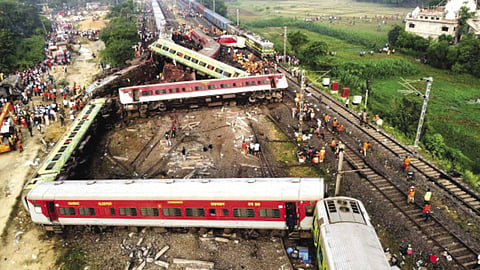Indian Railways possesses one of the world’s largest rail networks. But, after the recent accident in Odisha, it has become clear that fixing the nuts and bolts that hold it together has not only become necessary but also urgent.
The main railways investigation of the crash has said that human error and signalling lapses may have been responsible for the worst railway accident in three decades that killed 293 people. The report prepared by A.M. Chowdhary, Commissioner, Railway Safety (CRS), has flagged three main findings. One, botched repair works (one in 2018 and another, just hours before the accident) had compromised the signalling system; two, the repeated glitches were never flagged (the botched repair work in 2018 included cable faults that were fixed but not marked on a crucial circuit board); and three, wrong wiring and cable fault were also seen in a previous instance in West Bengal last year, but no corrective actions were taken.
In the wake of the accident, the Bharatiya Janata Party-led government at the Centre, as is its wont, spoke in many voices. Ashwini Vaishnaw, Union railways minister claimed that the ‘criminals’ were allegedly responsible for the horror and they have been identified. The Railway Board recommended an investigation of the accident by the Central Bureau of Investigation. Meanwhile, the railway authorities ruled out the probability of manual error. Their suspicions over the vulnerability of the interlocking system were swatted away.
“The lack of clarity in the wake of a monumental tragedy is distressing,” laments a retired member of the Railway Board. “The government owes the nation some clear answers. It must also assure citizens that the prospects of a repetition of such a tragedy would be minimised.” On top of that, the hate-mongers were eager to give a communal twist to the catastrophe.
Shift in policy vision
Of late, there has been a purported shift in policy vision, as far as the railways are concerned. There has been a decisive transition towards fast trains in the name of modernisation. This is evident from the emphasis being given to the long-delayed Mumbai-Ahmedabad bullet train network, Kerala’s SilverLine semi-high-speed train project and the Vande Bharat express trains.
At Rs2.4 lakh crore, the capital outlay for the railways in this year’s budget was one of the highest ever. So, the availability of monetary resources is not an issue. The problem, evidently, lies in the distribution of the kitty. Are adequate funds being spent on improving the railways’ safety standards? A report by none other than the Comptroller & Auditor General had discovered lapses of 30-100 per cent concerning inspections of structural conditions, despite the fact that derailments on account of poor maintenance are the principal cause of rail accidents in the country. An overhaul is a must!
But, policy reform, if any, will have to resist the bug of populism. While the government has increased investment in railway safety during the last five years, India’s safety systems are still not up to the mark. “The problem is essentially political in nature,” observes a transport specialist. “The political incentives are such that passenger tariffs are kept ridiculously low, while new trains are constantly introduced, burdening the track infrastructure to unbearable levels”. The low tariffs do not allow the passenger railways to recoup its losses and the resources available to enhance safety mechanisms remain minimal. “The political incentives also come in the way of removing human encroachments on railway infrastructure – which is another source of casualties,” he adds.
While the government is looking to fast-track the installation of its anti-collision system, kavach (protection), along with upgrading the signalling and centralised traffic control systems, experts are not convinced. “Even if these trains had kavach, there is no reason to believe it would have averted the accident. The kavach system is implemented in the engine, not on all coaches. If for some reason the engine and some coaches are disconnected, it will not be able to help. We have invested a lot of money and time on this,” says Subodh Jain, former member, engineering, Indian Railways.
Similarly, most engines and wagons used by the Indian Railways are not fitted with the latest braking technology. In fact, nearly 55 per cent of the wagons used by the Indian Railways are more than 10-15 years old.
“Indian Railways is upgrading tracks, as also rolling stock,” adds Jain. “But, most of the time, safety is not the primary criteria. When we promote Vande Bharat, we talk about its speed. We don’t claim it’s safer”. Thereby hangs a tale.

